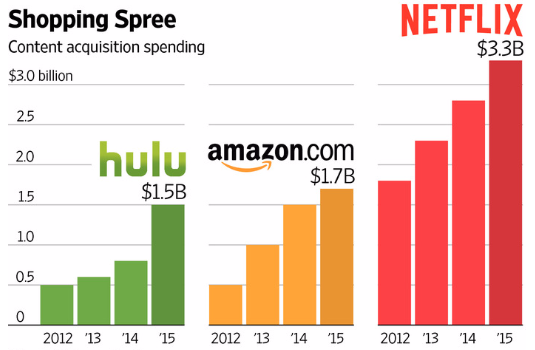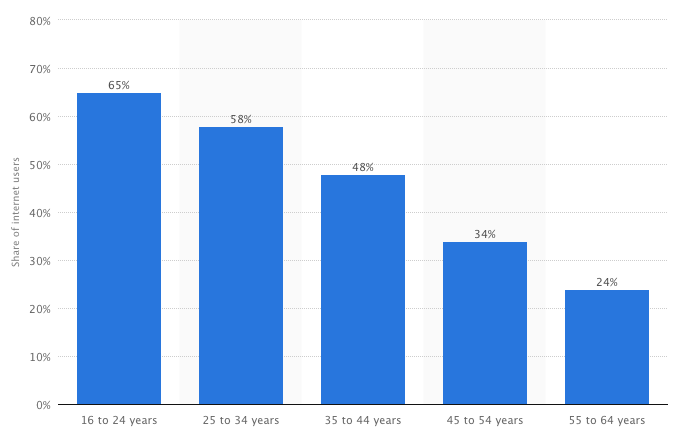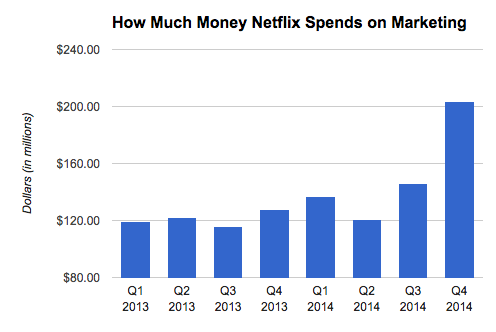Situation Analysis
Netflix, Inc. initially started as the world’s leading DVD rent-by-mail company with more than one million subscribers. However, the company is currently best known for its online media-streaming services as the television industry has changed dramatically since the initial launch of the company. Despite the fact that more and more customers are opting for online streaming options, Netflix managed to sustain 5.3 million DVD subscribers in 2015 (compared to 20 million in 2010), according to a New York Times article (Steel, 2015). In 2016, the company reported tremendous annual revenue growth ($8,830.67 million compared to $6,779.51 million in 2015) (Statista, 2016). Among the competitors of Netflix, Amazon and Hulu are the most prominent; however, their revenue from renting or online media-streaming services does not compare with that of Netflix, as seen from Figure 1 below:

The main goal of the strategic communication plan is Netflix’s expansion, which is necessary for attracting new sectors of customers that can potentially bring revenue to the company. According to statistics, only 28% of baby boomers and 38% of Generation X currently use Netflix, offering a massive challenge for the company’s PR efforts to increase the percentage of customers from older generations since catering to their interests is not an easy task. Furthermore, the company may set an objective of increasing the number of families that watch Netflix together, presenting another challenge for the strategic communication plan. It is impossible to target the same public relations efforts for capturing audiences of different ages: Each target group requires a specific set of efforts.
Goals
As has already been mentioned, there is a need for Netflix to attract new target audiences, especially from older generations. Among the key goals, the strategic communication plan for Netflix includes the following:
- Increase the sales and subscription rates of Netflix by families (not only by teenagers or young adults). More family-oriented content within Netflix can serve to achieve this goal. However, an effective strategic communication activity will be associated with engaging young people living with their parents to familiarize the older generations with the services Netflix provides. As seen from the report compiled by Statista (2015), 65% of Netflix users in the United States are between ages 16 and 24 (Figure 2):

In order for the younger generation to become engaged in sharing Netflix services with their families, Netflix can offer special family “packages” and deals.
- Familiarize baby boomers and Generation X with the benefits of a content subscription service and how it can be used, as well as emphasizing the ease with which these new audiences can become subscribers. Communicating the benefits of Netflix to older generations is not as easy as it may seem: The PR department should understand that communication with potential customers of an older generation might not necessarily take place online; therefore, the involvement of “traditional” sources of media to engage the audience in the conversation about how Netflix could be useful is essential.
- Create and popularize new public relations campaigns that would target audiences of older adults with regard to boosting the engagement of these groups in Netflix subscriptions.
Target Audience
Target audiences taken into consideration in this strategic communication plan include the generation of baby boomers (the population of adults aged between 53 and 71), Generation X (the population of adults aged between 34 and 54), and families with children.
It is important to take demographic information about families into account: Netflix is planning to target middle-class families with an average annual income of approximately $73,000 – $104,000 for an entire household (Elkins, 2017). The average spending of a middle-class family on food, transportation, housing, entertainment, and other services or products is approximately $40,000 a year, so it is important to take into consideration the rates for media streaming or rental services to cater to the spending abilities of middle-class families. It is expected that this type of household is relatively familiar with the new technologies of media streaming and regularly rents or buys movies or TV series. This audience is looking for content that will be friendly for different ages (family content), so Netflix should analyze its content to determine whether there are enough family-friendly programs that households will be interested in purchasing.
The generation of baby boomers is a group of people born between 1946 and 1964 (Gilles, n.d.). The name of the generation is associated with the dramatic increase in the rate of births following World War II. The population of baby boomers is characterized by its members having experienced social changes associated with the involvement of America in the Vietnam War in the late 1960s and early 1970s (Gilles, n.d.). Labeled as non-conformists, many baby boomers protested against the generally accepted social norms and were liberal in their expression of sexuality and the fight for women’s rights, as well as recognition of environmental problems (Gilles, n.d.). Furthermore, currently, the generation of baby boomers is secure financially and accepts consumption. All of these factors should be taken into account when designing a strategic communication plan targeted at this generation.
Generation X is a designated group of people who were born between 1965 and 1980. Similar to the experience of baby boomers, this generation has undergone some important social changes such as an increase in divorce rates and women entering the workforce. The influence of emerging television stations, computers, video games, and the birth of the Internet is also associated with this target group. Today, Generation X is known as a self-directed and individualistic group that values career growth and a steady income as necessary for raising children and providing for their future. This generation can also be included in the target audience of middle-class families.
While Figure 2 has provided some general understanding of the differentiation in Netflix’s usage among different generations, the preparation stage of the strategic communication plan should also include focus groups and interviews of the target audiences to find out how they approach the services Netflix provides, what their interests are, and whether there is a gap in the content that media-streaming services provide, as well as their overall attitudes to the world of the Internet (e.g., whether they prefer DVD renting services as opposed to online media streaming).
Message
The key message that Netflix should communicate to the target audience is that the company is inclusive of all ages and can offer content to cater to the needs of all customers regardless of their generation. Furthermore, it is important to put an emphasis on the accessibility of the services: Netflix offers the best prices on the market, provides discounts for families, and is sensitive to the purchasing abilities of the target audiences. Spreading the message of inclusivity is relevant in this day and age, especially as so many companies that predominantly offer their services on the Internet forget to target the needs of older generations because the latter do not make up the majority of the audience in this sphere. With regard to specific messages communicated in Netflix ads, the company can use slogans such as “Entertainment for the whole family,” “Netflix: Transcending generations,” and similar messages. Advertisements aimed at engaging new target audiences should underline the company’s desire to become a useful entertainment service for people of different ages and backgrounds. Uniting the family for a night of watching Netflix is a message that can attract a broad audience since family values is a concept that is respected by many people in the United States.
Increasing subscriptions to Netflix can be achieved by engaging the younger audience, already familiar with the company, and encouraging them to share the service with their parents or grandparents. Because older generations tend to learn about new technologies from younger people, such a strategy can boost engagement and attract new segments of customers. In return for referring parents or grandparents to Netflix, users can get bonuses and special offers from Netflix since such programs offer a win-win-win situation: Young people get bonuses, their parents/grandparents get to know about a valuable entertainment service, and Netflix increases its subscription base.
Tactics
Communicating the message of Netflix to its target audiences will require two approaches as strategies for attracting entire families and representatives of baby boomers or Generation X are usually different. With regard to promoting Netflix services to the segment of older adults who make up the smaller section of the company’s customer demographic, the company will place advertisements in newspapers that are readily available to the target audience. For example, free newspapers available in grocery stores or health-care facilities can become a good starting place for spreading awareness about the services. As a next stage, the public relations department will invest at least a month into investigating the most popular newspapers among the generations of baby boomers and Generation X to further target these papers. Moreover, it is important not to underestimate the importance of online publications because more and more older adults are familiarizing themselves with new media sources.
Creating TV ads that target baby boomers and Generation X is another important strategy that is expected to bring fruitful results. Because the rate of television viewing among adults increases after they reach the age of 50, there is a tremendous opportunity for Netflix to spread its message with the help of TV ads, especially when the marketing campaign will include representatives of the target generations. Finally, introducing content that appeals to the interests of older adults is crucial for motivating new customers to subscribe and stay engaged. It has been concluded that seniors like to watch TV to stay entertained; however, unlike younger generations, they prefer watching nonfictional content, which presents Netflix with a great opportunity. The company has acquired tremendous popularity with the introduction of documentaries such as West of Memphis, Poverty, Inc., Making a Murderer, Cosmos: A Spacetime Odyssey, and thousands of other programs, so it is important to underline the fact that Netflix offers a vast variety of nonfictional movies and series that customers can stream.
When it comes to targeting families, newspapers can also work; however, there is a need to engage young adults and teenagers and encourage them to familiarize their families with Netflix. Online ads such as “Get your family hooked on Netflix and get a discount” may start circulating on social media to attract young people’s attention. Discounts and subscription bonuses are especially helpful in this case because offering customers deals for referrals has proven an effective strategy for boosting engagement and sparking interest from new audiences. Similar to TV ads targeting older adults, Netflix can invest in filming commercials depicting families gathered to watch a movie together. More fresh family-friendly content is much needed to increase the subscription rates of new users; despite the fact that Netflix offers a tremendous selection of content that ranges from Star Trek to Gilmore Girls, introducing new TV shows that cannot be streamed anywhere else is a massive advantage for the service provider.
Timing
The timing of launching the campaign is of particular importance as it will set the tone for the entire round of efforts targeted at reaching new audiences for Netflix. While the company can start engaging older adults at any time, it is important to look at specific periods during the year when families are able to spend more time together. For example, the time when students return from college for summer vacation is a great opportunity to start promoting family subscription services. Holidays such as Thanksgiving, Christmas, the 4th of July, and other national holidays that bring families together should become a focus for the plan since the majority of families are likely to look for entertainment when they have more free time than usual. Furthermore, these holidays present Netflix with perfect opportunities to offer promotional codes and sales offers for families that have subscribed to the service as a show of respect for customers and their values.
Overall, the timing for the plan should cover at least one year so that the PR department of Netflix has an opportunity to compare the percentage of older adults watching Netflix in April of 2018 with the metrics attained in April of 2017. It will also take a year for the company to film new ads, start engaging with customers online, and collaborate with newspapers, as well as to begin investing time into finding new content that will be friendly for families and attractive to baby boomers and Generation X.
Sequence of Campaign Tactics
After conducting an analysis of the Netflix audience by age, the first step of the promotion campaign will be to establish a solid online presence and to start engaging younger audiences in promoting the media streaming service to their families (parents and grandparents). The next step is conducting research to find out what newspapers older generations read on a regular basis to determine in which print and online publications Netflix should post its ads to attract new customers. The third step involves filming TV ads with the participation of real families and representatives of older generations. Then, the company will collaborate with filmmakers to create new TV shows that will cater to the interests of older generations and families. The last step is to conduct another analysis of the Netflix audience by age to see whether the number of older customers has increased and whether more families have started buying family packages.
Budget
The initial budget for the campaign will come to $2,000,000; however, because the majority of promotional efforts will depend on paid media, the budget can increase over the course of the campaign. One of the costliest communication tactics is filming TV ads; the price for one ad can be as high as $500,000 if no celebrities are involved. Moreover, it is important to take into consideration that TV stations can also charge high prices for a single 30-second spot. For example, American Idol charges approximately $475,000 for a 30-second spot during a commercial break, though the median price for a place on national television is $100,000 (Wagner, n.d.). Airing ads on national television will be the best solution for Netflix since the company needs as much coverage as it can get, especially with regard to attracting older customers and families.
When planning a budget, it is also important to take into account the price of publishing an advertisement in newspapers. According to Aland (2016), the Washington Post charges $163,422 for a full-page ad with a circulation of 579,160 copies. Thus, in order for Netflix to attain extensive coverage in newspapers, the company may spend up to $1,000,000. Finally, it is worth looking at how much company used to spend on marketing quarterly before the increase in demand for Netflix media-streaming services (Figure 3):

Overall, the $2,000,000 budget for plan implementation coincides with the company’s standards of promoting its services to a larger audience. After 2014, Netflix started spending much more on marketing and promotion efforts, so the fixed budget is at the lower end of the company’s expenditures and can even increase if more coverage is needed.
Evaluation
Statistical evaluation of increases, decreases, or stability in the number of Netflix users by age will be the primary step in determining whether the strategic communication plan has succeeded. The company will also monitor relationships between the coverage of Netflix services on TV or newspapers and the engagement of users after being exposed to advertisements. For example, if after the airing of the Netflix ad, the number of family packages has started to increase, the company will deem the campaign as successful. On the other hand, if after publishing advertisements in newspapers, the number of older customers remains the same or increases insignificantly, then the campaign will be considered lacking in effectiveness. Among the potential metrics, the company will use media coverage (e.g., how much coverage did the campaign receive), interactive (e.g., how many customers saw the content), public inquiries (e.g., how many emails/calls did customer service receive after the coverage), and benchmarking (e.g., did the communication plan contribute to the improvement in metrics).
If the sales and subscription rates of Netflix by families increases compared to the previous indicators, baby boomers and the Generation X starts using the service more often, and the overall response to the new public relations campaign is positive (boosted engagement), the strategic communication plan will be regarded as beneficial for the company.
References
Aland, M. (2016). The ultimate guide to newspaper advertising costs and strategies. Web.
Elkins, K. (2017). Here’s how much money middle-class families earn in every US state. Web.
Gilles, G. (n.d.). What are baby boomers? Definition, age, & characteristics. Web.
How much money Netflix spends on marketing [Image] (2015). Web.
Shopping spree: Content acquisition spending [Image] (n.d.). Web.
Statista. (2015). Share of Internet users who use Netflix in the United States in the 1st quarter of 2015, by age group. Web.
Statista. (2016). Netflix’s annual revenue from 2002 to 2016 (in million U.S. dollars). Web.
Steel, E. (2015). Netflix refines its DVD business, even as streaming unit booms. Web.
Wagner, N. (n.d.). How much does television advertising really cost? Web.